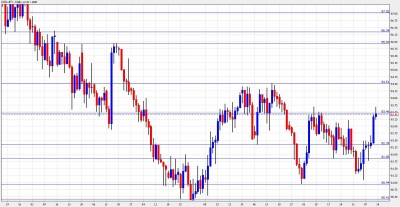Preliminary GDP and Rate decision, Monetary Policy Meeting Minutes and BOJ Monthly Report are the most significant events this week. Here is an outlook on the Market movers ahead.
Japanese Prime Minister Naoto Kan could face early election risk unless he manages to pass his record 92.4 trillion yen ($1.1 trillion) budget that begins in April of which 44.3 trillion yen must be funded by government bonds. Failure to pass the budget may force Kan to dissolve the lower house of parliament, triggering an election at a time of great difficulty for the Democratic Party of Japan.
USD/JPY daily chart with support and resistance lines marked. Click to enlarge:
- Preliminary GDP: Sunday, 23:50. The Japanese Gross Domestic Product grew by 0.9% in the September quarter 2010 above expectations of a 0.6% increase. GDP annualized rose 3.9% against 2.5% expected and Prelim GDP Price Index fell 2.0 % against -1.5% forecasted. A drop of 0.5% is expected now.
- Rate Decision: Thursday. The Bank of Japan’s policy board maintained its easy monetary policy unchanged with signs of a moderate recovery in the Japanese economy. Overnight rate is in a 0.0%-0.1% range. as stable financial markets and growing optimism toward the economic outlook give it room to sit back and gauge the effects of “comprehensive monetary easing” measures announced in October. The central bank indicated that exports are a bit weak. Many economists expect Japan’s central bank to ease policy further–such as by expanding its new asset-buying facility–later this year, especially if the yen rises again and weighs on business sentiment. Rates are not expected to change.
- Tertiary Industry Activity: Tuesday, 23:50. Japan’s Tertiary Industry Activity index rose in line with expectations in November rising by 0.6% following 0.3% rise in October. Industries that contributed to the increase include wholesale and retail trade, scientific research, transportation and electricity and water. A drop of 0.5% is predicted now.
- BOJ Monthly Report: Friday, 5:00. In its last monthly report, the central bank maintained its assessment that the economy is expected to improve and return to a moderate recovery path. Export is likely to rise reflecting on the global improvement as well as business investments and household spending. The government approved a record $1.1 trillion budget to boost the economy.
- Monetary Policy Meeting Minutes: Thursday, 23:50. The Bank of Japan opted not to alter monetary policy settings at its first meeting for 2011. Japan’s central bankers kept the target rate between 0% and 0.1% and did not announce any new quantitative easing measures. The BoJ started its asset purchases under the ¥5 trillion program in the final weeks of 2010, in a bid to boost liquidity in the economy and support the recovery.
- G20 Meetings: Friday-Saturday. France hosts the finance ministers and heads of the central banks of the G20 bloc of developed and major emerging economies. The ministers will follow up on the pledges made by the leaders at the close of the G20 summit of November in Seoul, particularly regarding exchange rates. They will also hear France’s priorities for the G20 as its 2011 president. These focus on global monetary system reforms, the enhancement of global governance and the stabilization of prices for raw materials.
* All times are GMT
USD/JPY Technical Analysis
After struggling with the 92.34 line (discussed last week), Dollar/Yen managed to break above it and climbed higher. It eventually settled just at the 83.40 line, making a big weekly gain.
The 83.40 should be closely watched at the beginning of the week. It capped the pair also beforehand. The next line above is 84.50 which is the highest level since October and is a very tough resistance line.
Higher, 85.93 was the top that the pair made after the BOJ intervention in September. It’s followed by 86.34 and 87.02 were support lines on the way down, and now work as minor resistance.
Above, strong resistance is found at 88.12, which worked in both direction last summer, and then by 89.15 which capped USD/JPY at that same period
Looking down, the 82.87 line, where the BOJ intervened, is very minor now. 82.34 now has a bigger role after giving a hard time to the pair.
Below, 81.80 is an important line after serving as a cushion in recent weeks. The next line is 80.87, which provided support back in November and now has the same role.
Even lower, 80.40, was the lowest close ever and by 79.75, the lowest intra-day level, reached back in 1995.
I remain bullish on USD/JPY.
A downgraded Japanese economy, higher US bond yields and an improved US economy should all aid the pair and push it higher.
Further reading:
- For a broad view of all the week’s major events worldwide, read the USD outlook.
- For EUR/USD, check out the Euro/Dollar forecast.
- For GBP/USD (cable), look into the British Pound forecast.
- For the Australian dollar (Aussie), check out the AUD to USD forecast.
- For the New Zealand dollar (kiwi), read the NZD forecast.
- For USD/CAD (loonie), check out the Canadian dollar.
